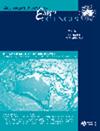Sedimentary characteristics and controlling factors of a Pliocene shelf-edge delta in the Papuan Basin
IF 0.9
4区 地球科学
Q3 GEOSCIENCES, MULTIDISCIPLINARY
引用次数: 0
Abstract
Abstract The Pliocene shelf-edge delta (SED) in the Papuan Basin was formed by deposition of the Pliocene Orubadi Formation. On the basis of a comprehensive analysis of seismic, wireline and mud logging, and paleontological data, the stratigraphic framework, depositional system and controlling factors on the SED development were established. The Orubadi Formation includes a parallel unconformity. Internally, two third-order sequences (SQ1/SQ2) are identified, and system tracts within the sequence layers are determined by the onlaps. By tracing changes in the shoreline trajectories within the sequence, the SED was divided into six phases in the study area, with seaward advances of ∼1543–5400 m during a single phase. The thickness of the foreset is ∼309–887 m, exhibiting sigmoid or sigmoid-tangential seismic reflections. The stratigraphic patterns and sedimentary system evolution of the Orubadi Formation are determined by the interplay between sea-level changes, sediment supply, tectonic evolution and paleogeomorphology. The Coral Sea spreading provided accommodation for the SED. The Miocene–Pliocene uplift and the middle Miocene arc–continent collision in northern PNG, which caused uplift and erosion of mountains in the late Miocene to Pliocene, is the major source of sediments. The large sediment supply and sea-level changes from SQ1–SQ2 indicate an overall relative sea-level fall resulted in rapid shelf margin advancement into the basin, with the Miocene carbonate platform edge providing the necessary slope conditions for material transport. This abundant sediment supply led to the significant development of the SED. This study provides robust insights for deep-water oil and gas exploration in the Papuan Basin. KEY POINTS The Pliocene shelf-edge delta (SED) in the Papuan Basin was formed in a compression setting with arc–continent collision. In the Orubadi Formation, the overall trend of sea-level change is decreasing, and the delta is divided into six stages. The Pliocene SED is controlled by the interplay between sea-level changes, sediment supply, tectonic evolution and paleogeomorphological.巴布亚盆地上新世陆架边缘三角洲沉积特征及控制因素
摘要巴布亚盆地上新世陆架边缘三角洲是由上新世奥鲁巴迪组沉积形成的。在综合分析地震、测井、录井和古生物资料的基础上,建立了SED发育的地层格架、沉积体系和控制因素。Orubadi组包括一个平行的不整合面。在内部,识别了两个三阶序列(SQ1/SQ2),序列层内的系统域由上盖层确定。通过追踪序列内海岸线轨迹的变化,SED在研究区域分为六个阶段,向海推进约1543–5400 m。包皮的厚度为~309–887 m、 表现出S形或S形切向地震反射。Orubadi组的地层格局和沉积体系演化是由海平面变化、沉积物供应、构造演化和古地貌相互作用决定的。珊瑚海的扩展为SED提供了便利。巴布亚新几内亚北部的中新世-上新世隆起和中新世弧-大陆碰撞是沉积物的主要来源,造成了中新世晚期至上新世山脉的抬升和侵蚀。SQ1至SQ2的大量沉积物供应和海平面变化表明,总体相对海平面下降导致陆架边缘快速向盆地推进,中新世碳酸盐岩平台边缘为物质运输提供了必要的斜坡条件。这种丰富的沉积物供应导致了SED的重大发展。这项研究为巴布亚盆地的深水油气勘探提供了有力的见解。要点巴布亚盆地上新世陆架边缘三角洲(SED)是在弧-陆碰撞的压缩环境中形成的。在奥鲁巴迪组,海平面变化总体呈下降趋势,三角洲分为六个阶段。上新世SED受海平面变化、沉积物供应、构造演化和古地貌之间的相互作用控制。
本文章由计算机程序翻译,如有差异,请以英文原文为准。
求助全文
约1分钟内获得全文
求助全文
来源期刊

Australian Journal of Earth Sciences
地学-地球科学综合
CiteScore
2.80
自引率
8.30%
发文量
45
审稿时长
6-12 weeks
期刊介绍:
Australian Journal of Earth Sciences publishes peer-reviewed research papers as well as significant review articles of general interest to geoscientists. The Journal covers the whole field of earth science including basin studies, regional geophysical studies and metallogeny. There is usually a thematic issue each year featuring a selection of papers on a particular area of earth science. Shorter papers are encouraged and are given priority in publication. Critical discussion of recently published papers is also encouraged.
 求助内容:
求助内容: 应助结果提醒方式:
应助结果提醒方式:


